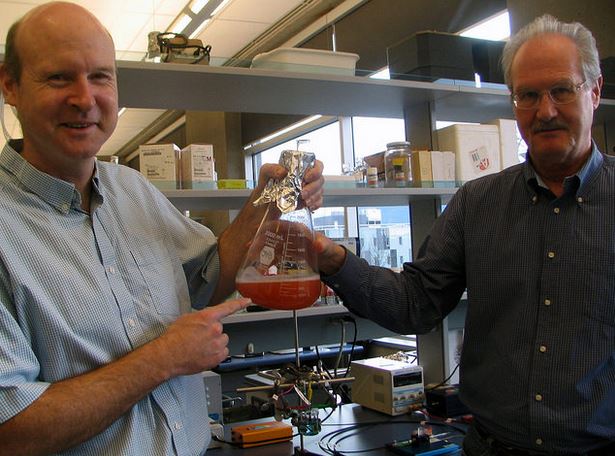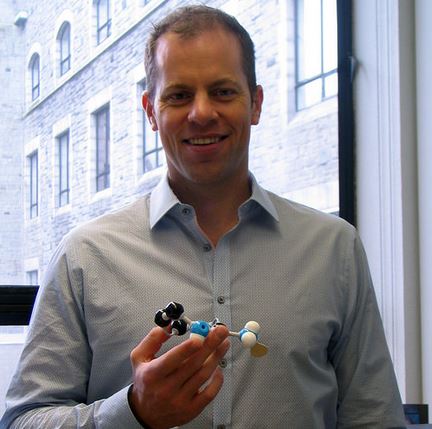Three Canadian researchers believe they could well have the solution to the global warming problem. They plan to use the power of photosynthesis to create a biological solar panel plus battery.
The three Canadians, researchers, microbiologist J. Thomas Beatty, bioengineer John Madden, and chemist Curtis Belringuette, all from the University of British Columbia, say they were inspired by mother nature to work across disciplines to develop a new generation of solar cells.
As Prof. Beatty was studying a protein, a thought brewed and grew in his mind. The more he thought about it the more he realized that the proteins involved in photosynthesis could behave like batteries.

Professors Madden (left) and Beatty have been working together for ten years trying to get electricity from sunlight using photosynthesis. (Image: UBC)
They all have, after all, positive and negative charges on opposing sides, just like batteries do. However, microbiologists are not experts in electrical circuits. In order to test his bio-battery idea, he needed help.
Prof. Beatty approached colleagues at UBC’s Faculty of Applied Science and met Prof. Madden, who had developed organic electronics and artificial muscles.
A ten-year partnership
Prof. Madden was intrigued by the bio-battery idea. And so started a partnership that has so far lasted for ten years.
Professors Madden and Beatty are working on the second version of a solar cell inspired by the photosynthetic reactions of microorganisms.
The problem with solar cells that are currently on the market is their lack of efficiency. They do not perform well at capturing low-angle sunlight, which means that in regions far from the equator, they are not very good at generating power.
Current commercial solar cells are able to convert sunlight into electrical power with an efficiency of just 10% to 25%.
Plants have spent millions of years perfecting the art of capturing the energy they need from the sun. Pigment molecules present in plant cells are able to absorb a wide range of solar wavelengths, allowing photons (tiny particles of light) to focus into proteins known as reaction centers (RCs) with super efficiency.
Professors Madden and Beatty are trying to do the same, by mimicking the process – using engineered versions of natural plant proteins to capture and store solar energy.
Three years ago, they patented a device – the bio-photovoltaic (bio-PV) – that can generate and store solar power with a single cell. It was fabricated using materials from Rhodobacter sphaeroides, a photosynthetic bacterium.

Imagine coating your windows with a dye and generating electricity from that, says Prof. Berlinguette. (Image: UBC)
They coated the surface of a carbon electrode with a layer of this genetically engineered protein, and were able to generate energy through an electrochemical process.
Prof. Beatty said “A cell that can both harvest and store energy provides a very low-cost energy solution.”
Their latest battery is more efficient, though it uses some inorganic components. The scientists hope to be able to commercialize this second-generation battery. However, they insist their ultimate goal is to create a fully organic solar battery.
Energy-generating dye
Associate Professor Curtis Berlinguette, from the Department of Chemical & Biological Engineering at UBC, is focusing on the improved dye-sensitized solar cells, a thin, semi-flexible solar cell.
Prof. Berlinguette said:
“What we do is coat a substrate, say your window, with titanium. Titanium is dirt cheap, it’s the white component that is in your toothpaste so it’s environmentally benign. The problem is titanium is white or translucent so it’s not a good solar harvesting material.”
At his lab, Prof. Berlinguette’s team engineer dyes that have intense colors. They stick to the titanium paste allowing for improved sunlight absorption.
Cities like Vancouver do not have the space or weather conditions of vast sunny regions of North America, such as Arizona, where installing solar farms is comparatively easy. However, the city is full of skyscrapers which could be used to generate solar power.

Imagine all the windows of the skyscrapers of Vancouver coated with energy-generating dyes.
Prof. Berlinguette explained:
“The types of solar cells we’re working on don’t require a reflective back layer, so we can start to incorporate these into windows.”
“If you’re going to have a window anyway we’ll coat it with our titanium and dyes, and you can generate electricity. There’s a great opportunity in urban markets to utilize this kind of technology.”
Professors Madden and Beatty envisage multiple applications for their solar panels. Given that their batteries have built-in storage capacity, they could be transported ready-made to remote regions that currently use diesel to meet energy requirements.
The researchers say “There may be something new under the sun, after all.”
UBC Video – Something new under the Sun
This UBC video shows how Professors Beatty, Madden and Berlinguette are developing a new generation of organic solar cells.
